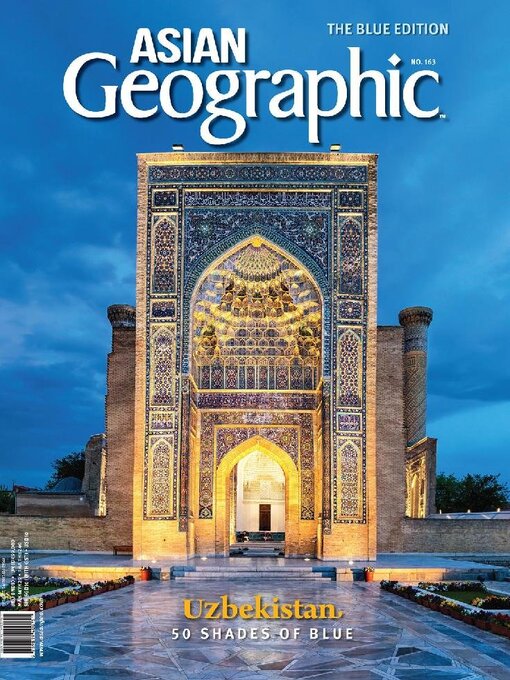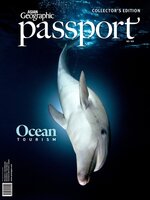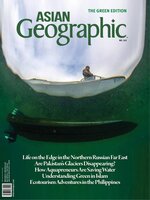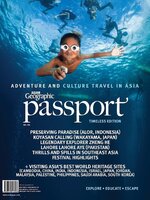ASIAN Geographic is the bi-monthly magazine that scours the region to bring readers the most compelling stories and images from the world's largest and most diverse continent. Readers enjoy a unique melting pot of breathtaking photography and in-depth features covering culture, nature, sustainability issues and exploration into the history of this diverse region. A regular 'Exploration' segment follows brave field editors as they travel deep into Asia's unexplored regions to take readers on a journey.
EDITOR’S NOTE
Uzbekistan 50 Shades of Blue • Offering a fascinating blend of Persian, Turco-Mongol, and Soviet influences, this Central Asian Islamic nation is bathed in blue and turquoise
60 Days for Our Blue Planet • Raising awareness about aquatic ecosystems, marine and riverine animals, and the need to protect our oceans and waterways
Our Ocean Under Threat • Human activities have been damaging the seas for decades, discharging pollutants and plastics into the water, overexploiting fish stocks, and raising the temperature and acidity levels. In this special feature, we look at the ocean’s most important ecosystems, and consider the most significant threats they face
The Importance of the Ocean • The oceans store carbon dioxide and are a vital source of oxygen
Plastics, Plastics Everywhere • On average, plastics take 10 to 1,000 years to break down into smaller pieces
Deadly Ghost Nets • Lost and abandoned fishing gear – “ghost gear” or “ghost nets” – makes up the majority of macroplastic (in excess of 20 centimetres) in the oceans. This ghost gear is a particularly deadly form of plastic pollution that is trapping, entangling, smothering and killing marine animals, particularly across Asia
Are Coral Reefs Our Most Valuable Ecosystems?
Threats to Corals
Dancing with the Devil
Manta Distribution • Manta rays occur in tropical, subtropical, and temperate waters of the Atlantic, Indian, and Pacific Oceans, often along productive coasts and offshore islands. The oceanic manta ray is found in tropical, subtropical and temperate waters and is more widely distributed than the reef manta, which is limited to the tropics and subtropics. Most manta rays migrate cyclically and fairly predictably across national boundaries.
The Economic Benefits of Manta Diving and Snorkelling
Equine Enigma
What’s Killing Seahorses?
Seahorse Socioeconomics
Cool Cruisers • For over a 100 million years, sea turtles have covered vast distances across the world’s oceans, filling a vital role in the healthy balance of marine habitats
6 Top Places to dive with Sea Turtles • Spotting these ancient reptiles on a dive can often make the dive, or take it to a new level. Divers often look for the more spectacular of aquatic species when they’re underwater, and the turtle is hardly an average Joe. Either flapping their boomerang-shaped fins at the surface, or grazing on seagrass like an oceanic cow, turtles are a must-see. We bring you the top places to dive with sea turtles.
Peerless Predators
Sharkopedia
Sustainable Seafood in Asia • Non-profit sustainable seafood certification programmes are not just restricted to Europe and the United States. The Marine Stewardship Council is working with fisheries across Asia to ensure all commercial fishing is done responsibly.
Is There Plastic in My Seafood? • The bag you carry your groceries home in, or the straw that you sip from, could end up in your stomach
How to Avoid Eating Plastics in Your Seafood
The Mystic Blue
Blue and Black Magic • With an abundance of verdant isles and diverse blue space, deciding where to visit in the Philippines can be a mind-boggling task. Yet, regardless of where you choose, you’ll be captivated...

 Issue 169
Issue 169
 Issue 168
Issue 168
 Issue 167
Issue 167
 Issue 166
Issue 166
 Issue 165
Issue 165
 Issue 164
Issue 164
 Issue 163
Issue 163
 Issue 162
Issue 162
 Issue 161
Issue 161
 Issue 160
Issue 160
 Issue 159
Issue 159
 Issue 158
Issue 158
 Jun 01 2022
Jun 01 2022
 May 01 2022
May 01 2022
 Apr 01 2022
Apr 01 2022
 Mar 01 2022
Mar 01 2022
 Feb 01 2022
Feb 01 2022
 Jan 01 2022
Jan 01 2022